Solve the circuit with nodal analysis and find ![]() and
and ![]() .
.

Solution
1) Identify all nodes in the circuit. Call the number of nodes ![]() .
.
There are four nodes in the circuit:
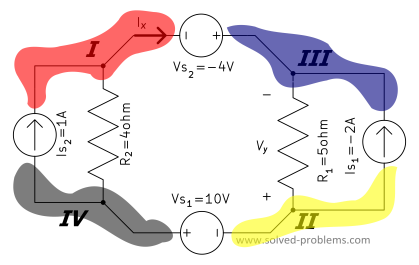
Therefore ![]()
2) Select a reference node
Because of symmetry in the circuit, any node can be chosen as the reference node.

3) Assign a variable for each node whose voltage is unknown.
There are three nodes beside the reference node:

Node I and Node III are connected to each other by a voltage source. Therefore, they form a supernode.
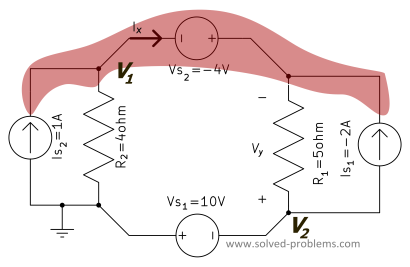
The voltage of Node III can be written in terms of the voltage of Node I. All we need to do is to apply KVL in the loop illustrated below.
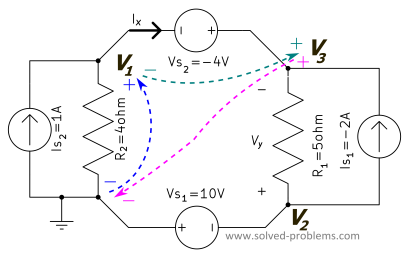
KVL: ![]() .
.
A good practice is to avoid assigning a voltage label to Node III and use ![]() as its voltage.
as its voltage.
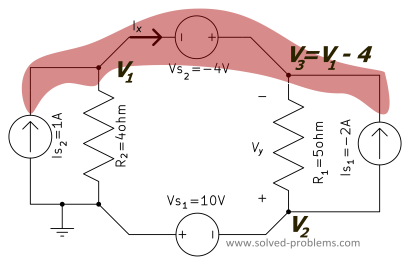
There is also another voltage source which connects Node II to the reference node. This voltage source must be used to obtain the node voltage. Since the negative terminal of the voltage source is connected to the node, ![]() . You can verify this by applying KVL to the loop between the reference node and Node II.
. You can verify this by applying KVL to the loop between the reference node and Node II.
4) Write down KCL equations.
We only need to write a KCL equation for the supernode:
![]() . Substituting
. Substituting ![]() and known variables,
and known variables,
![]() . Therefore,
. Therefore, ![]()
Now, we need to determine the required quantities:
KCL at node 1:
![]()
KVL around the loop shown in the figure below:
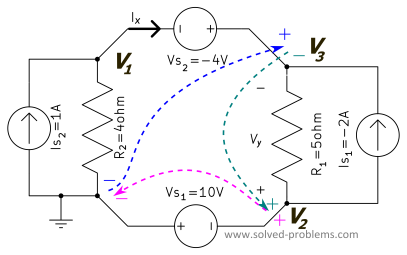
![]() .
.

Dear Dr. Li,
I signed up already for your web site, but I still have problems in order to download the book named Nodal Analysis (I tried with IDM and other programs), please help me to solve this trouble.
Awaiting your urgent reply.
Best regards,
Orhan TUNCOZ
dear dr. yaz z. li
i am about to start teaching network analysis to ug students of electrical and electronics engineering. thanks for explanation and your illustrations are too good that i want to follow. kindly let me know which software is used to draw the networks and highlighting relevant portions of the network. thanks and regards.
Hi there,
The latest one that I use is latex + circuitikz.
Hi Dr. Yaz Z. Li,
I am also teaching an electrical engineering class, and am playing around with circuitikz. Although I can do basic circuits, I have no idea how to do the colour highlighting that you have in this page. Would it be possible for you to post a sample code showing how to do this?
Thank you!
Alexis
Hi Alexis,
Actually, I used GIMP for highlighting here but for this post, I used fill as:
\fill[magenta,opacity=0.5] (-.5,-.5) -- (-.5,2.5) --(.5,2.5) -- (.5,-.5) ;
\fill[red,opacity=0.5] (-.5,4.5) -- (-.5,7.5) --(.5,7.5) -- (.5,4.5) ;
\fill[blue,opacity=0.5] (2.5,4.5) -- (2.5,7.5) --(3.5,7.5) -- (3.5,5.5) -- (5.5,5.5) --(5.5,4.5);
\fill[green,opacity=0.5] (2.5,-.5) -- (2.5,2.5) --(5.5,2.5) -- (5.5,1.5) --(3.5,1.5) --(3.5,-.5);
Let me know if you have any questions.
hey, i have a text on circuit analysis on thrusday and im having difficulties in complex situations, for instints. can i select a node as a reference node if it is connected to a voltage source, and that mean the nodal voltage of the node of the other side of the voltage source will be that of the voltage source.
thanks
brendon
hey, i have a test on circuit analysis on thrusday and im having difficulties in complex situations, for instints. can i select a node as a reference node if it is connected to a voltage source? If possible does that mean the nodal voltage of the node of the other side of the voltage source will be that of the voltage source.
thanks
brendon
Hi Brendon,
Yes, you can. We prefer to select such nodes as the reference node to have one of the node voltages known without need to solve. Please download my free ebook, these are explained there.
Good luck 🙂
i had the test, it was not hard. hope i passed it. thanks for your asistance.
hello…
I have already signed in to your website but still i have problem loading the book NODAL ANALYSIS .can u plz help me regarding loading of this book.
THANKS
Hi,
what about if you have a supernode that contains another supernode?
thanks
In that case, you consider all three nodes as a supernode. Label the voltage of one of the nodes and find the voltage of the other two nodes in terms of the voltage of the first node. (The same if there are even more than three nodes in a supernode.)
I signed up already for your web site, but I still have problems in order to download the book named Nodal Analysis, please help me to solve this trouble.
Randy
your analysis of super node realy realy give me a suppert to understand super node concept.please upload more then.
Hi sir yaaz !
Sir would you plz explain me how to solve a question in which a supernode contains. Another super node …
Thanks
sir i want to know that how to solve supernode problem when there is a resistance between two non reference nodes which makes a supernode i.e. the resistance is in series with the voltage source
If there is a resistance in series with a voltage source, their connection is supernode from the voltage source side.
Hello how can I solve a question that has a current source connected in parallel with two resistors